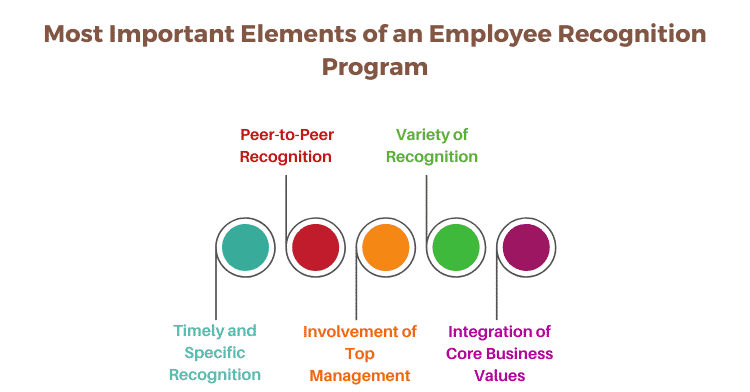Unlock the core components of a high-performance employee recognition programme — from alignment with company values and measurable criteria to inclusivity, user-friendly tools, and timely, meaningful celebration of achievement.
1. A perfect employee recognition program should include timely and specific recognition, peer-to-peer recognition, various recognition methods, top management involvement, and integration with core business values.
2. These elements ensure that employees feel valued, motivated, and engaged, which boosts morale, enhances productivity, and supports business growth.
3. When implemented effectively, such programs help retain top talent and create a positive workplace culture that aligns with organizational goals.
Employee engagement and motivation have become significant focus areas for most organizations today. Understanding the critical elements of an effective employee recognition program is essential for any organization.

The objective of any employee recognition program is to celebrate employee efforts and achievements and make them feel valued.
When implemented correctly, these programs can provide significant benefits for an organization:
1. Help boost employee morale and motivation, which, in turn, can enhance their efficiency and drive business growth.
2. Improve the overall profitability of an organization by enhancing employee productivity and work quality.
3. Ensure better retention of top talent by appreciating and rewarding them for their excellent work and contribution.
4. Inspire employees to work harder and better to receive the same kind of recognition as their colleagues.

To leverage the full benefits offered by a recognition program, organizations must provide recognition effectively.
Hence, recognition should be specific, timely, regular, and public to make it more impactful.
Additionally, organizations should ensure that the recognition is inclusive and well-integrated with their critical corporate values.

These factors combine to make the recognition more authentic and inspiring for employees.
Organizations should focus on incorporating the key elements of an effective employee recognition program to enhance its effectiveness.
Even though organizations implement employee recognition programs in different ways, there are a few key elements that every such program should feature.
The most critical elements of a perfect employee rewards and recognition program are as follows:
1. Timely and Specific Recognition
2. Involvement of Top Management
3. Peer-to-Peer Recognition
4. Variety of Recognition
5. Integration of Core Business Values


The organization must ensure that the recognition program can identify and recognize deserving employees spontaneously.
Timely recognition motivates employees and inspires them to continue to give their best for business growth.
Moreover, the program should focus on recognizing specific efforts, achievements, and even specific behaviors of employees.
It is essential to maintain the program’s relevance and authenticity.
At a global manufacturing company, managers can instantly recognize their team members without prior approval using the HiFives platform. Employees receive e-certificates and reward points, which they can redeem for e-gift cards.

The effectiveness of recognition often depends on how actively the top management participates in the program.
Active participation of the top management sends out a strong positive message about the significance of the program.
They feel assured that the organization’s top leaders value their efforts and achievements.
It can go a long way in enhancing employee engagement and keeping them motivated about the recognition program.
At a healthcare startup, the founders personally felicitate the winners of the ‘Employee of the Month’ award during the monthly town hall in the presence of the entire workforce.

Peer-to-peer recognition holds about the same level of significance as recognition from top management.
Being appreciated by their peers and co-workers for their good work and achievements fills the employees with a sense of pride and accomplishment that is quite unmatched.
It assures the employees that their colleagues genuinely respect them. Rather than causing resentment among their fellow workers, they have managed to win their trust and appreciation.
It can help increase the employees’ engagement level and make them feel valued.
At a fashion retail company in the Middle East, store associates and other employees can appreciate and thank one another by sending e-cards through the HiFives platform.

Organizations must maintain employee interest in the recognition programs to keep reaping their benefits.
This can be ensured by increasing the variety of recognition so that the employees feel constantly excited and curious about the program.
Organizations can promote diversity in recognition by rewarding and acknowledging employees across different levels and under various criteria.
Therefore, this increases the program’s coverage and helps build a happier and more satisfied workforce.
An insurance company’s employee rewards and recognition program includes spot awards, peer-to-peer recognition, monthly and quarterly awards, as well as rewards for various contests and events. Peers and managers can nominate their team members for multiple awards and recognitions through the HiFives platform.

Building a perfect recognition program is nearly impossible unless it integrates with an organization’s core values.
So, this ensures that employee engagement is for the right reasons, which, in turn, helps in reinforcing the organization’s culture effectively.
Hence, the organization should establish performance and behavioral criteria for rewards and recognition to integrate the program with corporate values.
Therefore, these factors should serve as the basis for a robust and effective recognition policy and system development.
At a global analytics and AI company, employees can recognize one another with digital badges on the HiFives platform when they demonstrate the organization’s core values. The recognition gets posted on HiFives and Microsoft Teams through integration for greater social visibility.

It boosts morale, motivation, productivity, and retention of top talent, while also aligning the workforce more closely with business goals.
1. Timely & Specific Recognition
2. Top Management Involvement
3. Peer-to-Peer Recognition
4. Variety of Recognition
5. Integration with Core Business Values
Prompt recognition reinforces the positive behavior immediately. Being specific (mentioning the exact effort or behavior) makes it more meaningful and credible.
Leadership involvement adds weight and legitimacy to the recognition program. It signals that recognition is not just superficial, but valued at the highest levels.
Recognition from peers creates a sense of mutual respect and belonging, making employees feel appreciated by those who understand their day-to-day challenges.
Variety prevents monotony, keeps engagement high, and allows the organization to recognize different employees in ways that resonate with them.
The behaviors rewarded should reflect the organization’s values, ensuring that recognition reinforces the culture and strategic goals.
Combine timeliness, specificity, visibility, leadership involvement, and value alignment. When all these work together, recognition feels genuine and motivational.
Begin by mapping and incorporating those key elements (timeliness, specificity, variety, peer involvement, leadership, and values) into your design to guide all further choices.
Understanding the key elements of a perfect employee recognition program is the first and the most important step that organizations need to take in the direction of developing such a system that is effective in motivating their employees and driving business growth.

Lead author: Sagar Chaudhuri, the Co-Founder and CEO of HiFives. He is an HR Tech Evangelist with over 25 years of experience in both corporate and entrepreneurial settings. Previously, Sagar has held leadership roles with companies such as Genpact, Infosys, and ICICI Bank. He has an engineering degree from IIT Kharagpur and an MBA from IIM Lucknow. Connect on LinkedIn
To stay updated on the latest HiFives blogs, follow us on Twitter (@MyHiFives)